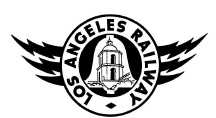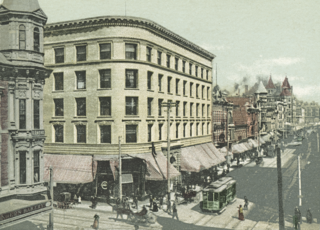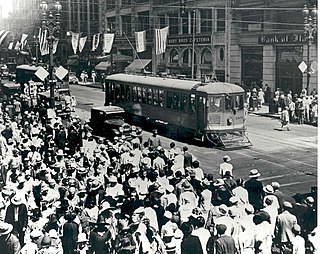This article needs additional citations for verification .(December 2022) |
10 refers to two streetcar lines in Los Angeles, California. They operated by the Los Angeles Railway for a combined period from 1932 to 1946.
This article needs additional citations for verification .(December 2022) |
10 refers to two streetcar lines in Los Angeles, California. They operated by the Los Angeles Railway for a combined period from 1932 to 1946.
| 10 | |
|---|---|
| Overview | |
| Locale | Los Angeles |
| Termini |
|
| Service | |
| Type | Streetcar |
| System | Los Angeles Railway |
| History | |
| Opened | June 12, 1932 |
| Closed | November 30, 1942 |
| Technical | |
| Track gauge | 3 ft 6 in (1,067 mm) |
| Electrification | Overhead line, 600 V DC |
The route started in 1932 as a combination of two former lines: the M on Arlington Avenue and the A Line Broadway segment. It ran from Vernon and Arlington in the south to Lincoln and Mission in Lincoln Heights. [1] In 1939 the Broadway line was reassigned to the W and service was rerouted all the way to the Edgeware line in Angelino Heights, but this was cut back to 39th on New Year's Day 1943. [2] At the time of its closure, the route ran from Grand Avenue and 39th Street to the intersection of Vernon and Arlington Avenues, by way of Grand Avenue, Santa Barbara Avenue, Dalton Avenue, and Vernon Avenue. The service ended on November 30, 1942; the Edgeware Road Line continued to operate as a shuttle, designated number 37, until mid-1946. [3]
| 10 | ||||||||||||||||||||||||||||||||||||||||||||||||||||||||||||||||||||||||||||||||||||
|---|---|---|---|---|---|---|---|---|---|---|---|---|---|---|---|---|---|---|---|---|---|---|---|---|---|---|---|---|---|---|---|---|---|---|---|---|---|---|---|---|---|---|---|---|---|---|---|---|---|---|---|---|---|---|---|---|---|---|---|---|---|---|---|---|---|---|---|---|---|---|---|---|---|---|---|---|---|---|---|---|---|---|---|---|
| Overview | ||||||||||||||||||||||||||||||||||||||||||||||||||||||||||||||||||||||||||||||||||||
| Locale | Los Angeles | |||||||||||||||||||||||||||||||||||||||||||||||||||||||||||||||||||||||||||||||||||
| Termini |
| |||||||||||||||||||||||||||||||||||||||||||||||||||||||||||||||||||||||||||||||||||
| Service | ||||||||||||||||||||||||||||||||||||||||||||||||||||||||||||||||||||||||||||||||||||
| Type | Streetcar | |||||||||||||||||||||||||||||||||||||||||||||||||||||||||||||||||||||||||||||||||||
| System | Los Angeles Railway | |||||||||||||||||||||||||||||||||||||||||||||||||||||||||||||||||||||||||||||||||||
| History | ||||||||||||||||||||||||||||||||||||||||||||||||||||||||||||||||||||||||||||||||||||
| Opened | June 21, 1943 | |||||||||||||||||||||||||||||||||||||||||||||||||||||||||||||||||||||||||||||||||||
| Closed | January 17, 1946 | |||||||||||||||||||||||||||||||||||||||||||||||||||||||||||||||||||||||||||||||||||
| Technical | ||||||||||||||||||||||||||||||||||||||||||||||||||||||||||||||||||||||||||||||||||||
| Track gauge | 3 ft 6 in (1,067 mm) | |||||||||||||||||||||||||||||||||||||||||||||||||||||||||||||||||||||||||||||||||||
| Electrification | Overhead line, 600 V DC | |||||||||||||||||||||||||||||||||||||||||||||||||||||||||||||||||||||||||||||||||||
| ||||||||||||||||||||||||||||||||||||||||||||||||||||||||||||||||||||||||||||||||||||
A wholly new route was assigned the number 10 on June 21, 1943, running over Vernon, Dalton, and Santa Barabara and extending to Vermont and 39th at rush hours. [2] This 10 ran until January 27, 1946, when it was converted to bus operation. [4]

The Los Angeles Railway was a system of streetcars that operated in Central Los Angeles and surrounding neighborhoods between 1895 and 1963. The system provided frequent local services which complemented the Pacific Electric "Red Car" system's largely commuter-based interurban routes. The company carried many more passengers than the Red Cars, which served a larger and sparser area of Los Angeles.

Venice Boulevard is a major east–west thoroughfare in Los Angeles, running from the ocean in the Venice district, past the I-10 intersection, into downtown Los Angeles. It was originally known as West 16th Street under the Los Angeles numbered street system.
J was a streetcar line in Los Angeles, California. It was operated by the Los Angeles Railway from 1911 to 1945, by Los Angeles Transit Lines from 1945 to 1958, and by the Los Angeles Metropolitan Transit Authority from 1958 to 1963.

P was a streetcar line in Los Angeles, California, United States. It was operated by the Los Angeles Railway from 1895 to 1958, and by the Los Angeles Metropolitan Transit Authority from 1958 to 1963.
V was a streetcar service in Los Angeles, California. It was operated by the Los Angeles Railway from 1920 to 1958, and by the Los Angeles Metropolitan Transit Authority from 1958 to 1963.
5 or the 5 Car was a streetcar line operated by the Los Angeles Railway, later named the Los Angeles Transit Lines, and by the Los Angeles Metropolitan Transit Authority. From 1920 to 1932, this route was known as the E Car. This was changed as part of a method to distinguish routes that lacked loops at their termini. Consequently, the 5 Car was unique during the LAMTA era in that it did not use PCC streetcars. It used buses from 1955 to 1964, transferring from LATL in 1958, then splitting the line in two in 1961, until all lines were turned over to SCRTD in August 1964.

7 was a streetcar line in Los Angeles, California. The service was operated by the Los Angeles Railway from 1932 to 1955. It ran from Spring and 2nd Streets to Athens and 116th Street, by way of Spring Street, Main Street, Broadway Place, Broadway, and Athens Way. During its Los Angeles Transit Lines days, around 1950 to 1955, Line 7 was rerouted off South Broadway to Central Avenue, at least as far north as 7th Street across Olympic Boulevard to possibly Vernon Avenue, covering trackage that was abandoned rail by line U, when that line was converted to trolley bus August 3, 1947.
8 was a streetcar line in Los Angeles, California. It was operated by the Los Angeles Railway from 1932 to 1955.
9 was a streetcar line in Los Angeles, California. It was operated by the Los Angeles Railway from 1932 to 1955.
F was a streetcar line in Los Angeles, California. It was operated by the Los Angeles Railway from 1911 to 1955.

W was a streetcar line in Los Angeles, California. It was operated by the Los Angeles Railway (LARy) from 1895 to 1956.
3 was the number assigned to two distinct streetcar lines operated by the Los Angeles Railway in Los Angeles, California. Combined, they operated from 1924 to 1947.

The Venice Short Line was a Pacific Electric (PE) interurban railway line in Los Angeles which traveled from downtown Los Angeles to Venice, Ocean Park, and Santa Monica via Venice Boulevard. The route was especially busy on Sundays, as Venice was PE's most popular beachfront destination.

U was a streetcar line in Los Angeles, California. Also referred to as the University Line, it provided service to the University of Southern California.
A refers to several streetcar routes in Los Angeles, California. The lines were operated by the Los Angeles Railway and its successor, Los Angeles Transit Lines, from 1920 to 1946.
C refers to two streetcar routes in Los Angeles, California. The lines were operated by the Los Angeles Railway from 1910 to 1932.
G refers to several streetcar routes in Los Angeles, California that ran via Griffith Avenue. The lines were operated by the Los Angeles Railway from 1910 to 1946.

Cable car street railways first began operating in Los Angeles in 1885 and lasted until 1902, when the lines were electrified and electric streetcars were introduced largely following the cable car routes. There were roughly 25 miles (40 km) of routes, connecting 1st and Main in what was then the Los Angeles Central Business District as far as the communities known today as Lincoln Heights, Echo Park/Filipinotown, and the Pico-Union district.
L was a streetcar line in Los Angeles, California. It was operated by the Los Angeles Railway from 1920 to 1940.

M refers to several streetcar routes in Los Angeles, California. The lines were operated by the Los Angeles Railway from 1917 to 1941.